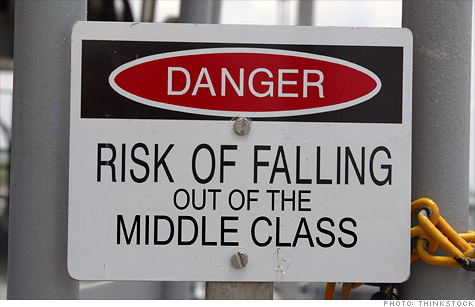
Nearly one-third of middle class suffer downward mobility.
NEW YORK (CNNMoney) -- Nearly one third of Americans who were raised in the middle class dropped down the economic ladder as adults -- and that's before the Great Recession hit.
"Being raised in the middle class is not a guarantee that you'll have that same status as an adult," said Erin Currier, project manager at Pew's Economic Mobility Project. "With all the economic turmoil in the past four years, there's good reason to think that downward mobility is more severe."
Pew looked at children born in the early- to mid-1960s and assessed their economic status roughly 40 years later.
Being middle class in the parents' generation meant a household income of roughly $33,000 to $64,000 in 1979. But their children had to earn between $54,000 and $111,000 to maintain their relative standing in society in the mid-2000s. (These figures are adjusted for inflation.)
The middle class is defined as those between the 30th and 70th income percentile.
Marital status and educational attainment had a great bearing on whether people were able to remain in the middle class, Pew found. Race and gender were also factors.
Those who are divorced, widowed or separated are more likely to fall out of the middle class, particularly if they are women. And Americans who don't attend college are also more likely to slip.
One's foothold on the middle class is more secure if you are a white man. Thirty percent of white women and 38% of black men drop out of the middle class, while only 21% of white men do.
Things have only gotten worse in recent years. The Great Recession has likely made it harder for many people to remain in the middle class, experts said.
Long-term unemployment has devastated the ranks of the middle class, with many people losing their homes and forced to turn to food banks and government aid after they run through their savings. It takes nearly 41 weeks, on average, for the jobless to find new work. Also, the steep decline in home values has hurt many in the middle class.
Recovering from a huge drop in income is not easy, a separate Pew study found. Half of people who lost more than 25% of their income in 1994 had not recovered four years later. And a third did not regain their economic footing after 10 years.
While it remains to be seen how quickly Americans will recover from the current economic downturn, Currier suspects it could take even longer.
Young adults may find it particularly difficult to hold onto their parents' middle class status. That's because they are having a much harder time landing jobs, particularly well-paying positions in their field. The unemployment rate for 20- to 24-year-olds was 14.4% in December, compared to the national 8.5% rate.
This could hurt their earning potential for decades to come, which has earned them the nickname "The Lost Generation."
"Entering your career in a down economy has lifelong ramifications," said Scott Winship, economic studies fellow at Brookings Institution. ![]()
| Overnight Avg Rate | Latest | Change | Last Week |
|---|---|---|---|
| 30 yr fixed | 3.80% | 3.88% | |
| 15 yr fixed | 3.20% | 3.23% | |
| 5/1 ARM | 3.84% | 3.88% | |
| 30 yr refi | 3.82% | 3.93% | |
| 15 yr refi | 3.20% | 3.23% |
Today's featured rates:
| Latest Report | Next Update |
|---|---|
| Home prices | Aug 28 |
| Consumer confidence | Aug 28 |
| GDP | Aug 29 |
| Manufacturing (ISM) | Sept 4 |
| Jobs | Sept 7 |
| Inflation (CPI) | Sept 14 |
| Retail sales | Sept 14 |